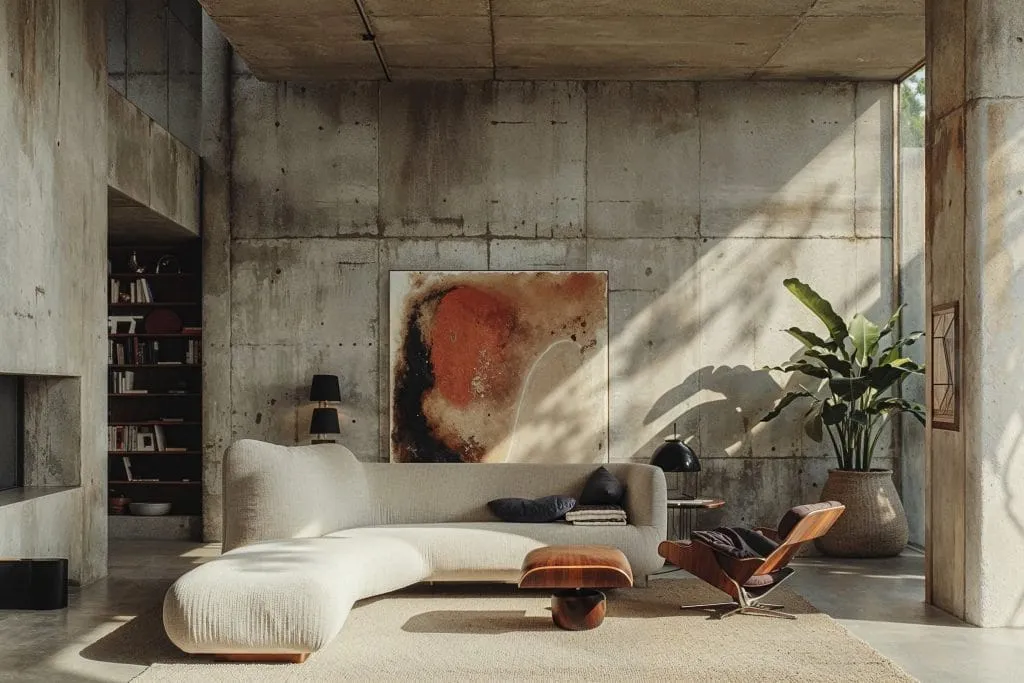Introduction: More than the Cold Façade
What do you think of when you hear the phrase “Brutalist architecture”? For a lot of people, it’s a harsh, overwhelming picture of raw concrete, geometric shapes, and a sense of coldness. Brutalism started in the middle of the 20th century and was a trend that praised the natural beauty of materials, especially béton brut (raw concrete). Brutalist principles can be very impressive on the outside, but they can also be used on the inside to make spaces with a lot of character and warmth that you wouldn’t anticipate. This article will show you how to take the aggressive style of Brutalist interior design and turn it into a cosy, elegant space.
The Essence of Brutalism: Unpacking Its Core
We need to know the basic ideas behind Brutalist interior design before we can really appreciate and use it. It’s not simply concrete barriers; it’s a way of life.
- Raw Materials: It’s really important to celebrate materials in their natural, unadulterated state. Think of things like rough-hewn wood, unpainted brick, exposed concrete, and industrial metals like steel and iron. These parts create a story of being honest and real.
- Geometric Forms: Brutalism is known for its bold, often repeated geometric shapes. This might show up in structural parts, furnishings, or even decorative touches, giving the space a sense of order and visual power.
- Functionality Over Ornamentation: Brutalism is true to its modernist roots in that it puts function first. Every part should have a purpose, and there shouldn’t be too much ornamentation. Instead, there should be clean lines and useful design.
- Monochromatic or Limited Colour Palettes: Brutalist interiors frequently use muted, natural colour schemes that let the textures of the materials shine through. These colour schemes aren’t strictly black and white. Greys, charcoals, whites, and earthy colours are the most common.
- The first step to making a real Brutalist-inspired interior that feels planned and important, not just incomplete, is to understand these ideas.
Minimal brutalist interior by DECORILLA designer, Joyce R.
The Art of Softening the Edges to Add Warmth
Now, for the most important part: how can we take these obviously harsh parts and make them feel warm and welcoming? It’s about layering and contrasting in a smart way.
The Power of Texture: Not Just Concrete
Concrete is important, but it shouldn’t be the only texture. Add a range of different textures to make the overall feel softer.
Textiles: plush rugs (wool, shag, or high-pile), thick velvet drapes, knitted throws, and linen furniture are all good examples. They soak up sound and add an important layer of softness.
Wood Accents: Use warm-toned woods like a live-edge dining table, a reclaimed wood console, or even wooden panelling on one wall. Wood adds a natural warmth that goes very well with the chill of concrete.
Natural Stone: Natural stone, like travertine or slate, is still a hard material, but it can add small changes in colour and texture that feel more natural than polished concrete.

Image sources: whisperingbold.com
Strategic Lighting: Crafting Ambiance
Lighting is one of the most potent ways to change a room, and it’s a must-have in a Brutalist interior. Harsh overhead lighting will only make things feel colder.
Layered lighting: When you use different types of lighting to create different effects. For example, you can use ambient lighting to light up the whole space, task lighting to light up certain activities, and accent lighting to highlight certain features.
Warm Tones: Choose bulbs that are a little warmer in colour, such 2700K to 3000K.
Statement Fixtures: Pendant lights in an industrial style, lamps made of concrete, or simple floor lamps can all add to the look while also creating welcoming pools of light.
Dimmers: Put dimmers on all the lights so you can change the mood from bright and useful to soft and cosy.

Image sources: whisperingbold.com
Introducing Organic Life: The Green Touch
Bringing nature indoors makes a room feel warmer right away. Plants may give colour, texture, and a sense of life that can make concrete look even more stark.
Large Statement Plants: A Fiddle Leaf Fig, a Monstera, or a Snake Plant in a raw concrete or terracotta container can be the main focus of the room.
Cascading Greenery: Pothos or philodendrons that hang from shelves or pots soften severe edges.
Arrangements: Even small arrangements of dried grasses or branches in minimalist vases can add a natural touch without making the look too busy.
The Art of Curated Color: Subtle Pops and Earthy Tones
Brutalism works best with a muted colour scheme, but adding properly chosen colours can give the look more depth and warmth without taking away from the main style.
Earthy Hues: You can add earthy colours like deep terracotta, muted olives, warm browns, and sandy beiges with fabrics, pottery, or accent furniture.
Rich Jewel Tones (Sparing Use): A single deep emerald cushion or a sapphire throw might provide a touch of luxury to the rough materials. The most important thing is to hold back.
Monochromatic tonal play: Use only one colour family, such different shades of grey, from charcoal to light silver, to make things look interesting by changing the colour and texture very slightly.

Image sources: artofit.org
Choosing Furniture: Style, Function, And Comfort All Matter
Brutalist furniture is usually strong, sculptural, and useful. But you shouldn’t give up comfort.
Bold Silhouettes: Look for furniture with bold, straightforward lines that are often too big and heavy.
Upholstery: Choose natural materials like linen, wool, or leather for your upholstery. Deep-seated sofas and chairs make you want to rest.
Minimalist yet Cosy: It’s important to have a few well-chosen, comfy objects, but you should minimise clutter. A big, comfortable sectional sofa or a well-designed lounge chair can make the living room feel more like home.
Repetition: Like the design of the building, using the same shapes or materials over and again in furniture may make a strong and unified look.

Image sources: artofit.org
Brutalism in Every Room, Not Just the Living Room
You can use the ideas of warm Brutalism in every room of your house.
Kitchen: Exposed concrete countertops or a raw concrete island with warm wood cabinets and industrial pendant lights.
Bedroom: A wall of exposed concrete or brick behind a bed with layers of soft, natural bedding. Nightstands with simple, geometric designs and warm task lighting.
Bathroom: The bathroom has a concrete washbasin, big grey tiles, wooden accents for storage and lots of green plants.

Image sources: artofit.org
Conclusion: A Place of Peace and Strength
Brutalist interior design doesn’t mean making an environment that is chilly and unwelcoming. It’s about being honest with materials, being strong with form, and finding beauty in simplicity. You can turn the raw power of Brutalism into an interior that is not only visually remarkable but also deeply appealing and completely distinctive by carefully combining natural textures, soft lighting, organic accents, and comfort. Don’t believe the stereotype; look for the unexpected warmth that lies behind the concrete.
For more blogs like this CLICK HERE!
References
How to Style Brutalist Interiors for a Bold Yet Cosy Home
40 Brutalism Interior Design Ideas Strong Raw Minimalist Spaces






